The Interaction of Antenatal Steroid Timing and Pre-Eclampsia on Respiratory Outcomes Among Infants Born Preterm
IF 3.9
2区 医学
Q1 PEDIATRICS
引用次数: 0
Abstract
Objective
To evaluate the effect of timing of antenatal steroid (ANS) administration and its interaction with pre-eclampsia on respiratory outcome among infants born preterm.
Study design
This was an analysis of a prospective, single-center cohort of infants born between 23 and 30 weeks of gestation between 2012 through 2021. End points were severe respiratory distress syndrome (sRDS) and moderate-to-severe bronchopulmonary dysplasia (msBPD). ANS administration was classified as within 7 days of birth or earlier than 7 days before birth. Multivariable generalized estimating equations were used to model the association between ANS timing and pre-eclampsia with the end points.
Results
The cohort included 1172 infants, of whom 30% were born to mothers with pre-eclampsia and 83% to mothers who received ANS within 7 days of birth. Compared with non–pre-eclampsia with ANS within 7 days of birth, pre-eclampsia with ANS earlier than 7 days before birth was associated with an increased risk for sRDS. Pre-eclampsia with ANS within 7 days of birth was not associated with an increased risk for sRDS. Compared with non–pre-eclampsia with ANS within 7 days of birth, non–pre-eclampsia with ANS earlier than 7 days of birth, and pre-eclampsia with ANS earlier than 7 days before birth were associated with an increased risk for msBPD. Pre-eclampsia with ANS within 7 days of birth was not associated with increased risk of msBPD.
Conclusions
In this cohort, properly timed maternal ANS administration within 7 days of birth was associated with a reduced risk of sRDS and msBPD among infants born preterm to mothers with pre-eclampsia. These findings underscore the need to optimize the timing of ANS administration.
求助全文
约1分钟内获得全文
求助全文
来源期刊

Journal of Pediatrics
医学-小儿科
CiteScore
6.00
自引率
2.00%
发文量
696
审稿时长
31 days
期刊介绍:
The Journal of Pediatrics is an international peer-reviewed journal that advances pediatric research and serves as a practical guide for pediatricians who manage health and diagnose and treat disorders in infants, children, and adolescents. The Journal publishes original work based on standards of excellence and expert review. The Journal seeks to publish high quality original articles that are immediately applicable to practice (basic science, translational research, evidence-based medicine), brief clinical and laboratory case reports, medical progress, expert commentary, grand rounds, insightful editorials, “classic” physical examinations, and novel insights into clinical and academic pediatric medicine related to every aspect of child health. Published monthly since 1932, The Journal of Pediatrics continues to promote the latest developments in pediatric medicine, child health, policy, and advocacy.
Topics covered in The Journal of Pediatrics include, but are not limited to:
General Pediatrics
Pediatric Subspecialties
Adolescent Medicine
Allergy and Immunology
Cardiology
Critical Care Medicine
Developmental-Behavioral Medicine
Endocrinology
Gastroenterology
Hematology-Oncology
Infectious Diseases
Neonatal-Perinatal Medicine
Nephrology
Neurology
Emergency Medicine
Pulmonology
Rheumatology
Genetics
Ethics
Health Service Research
Pediatric Hospitalist Medicine.
 求助内容:
求助内容: 应助结果提醒方式:
应助结果提醒方式:


